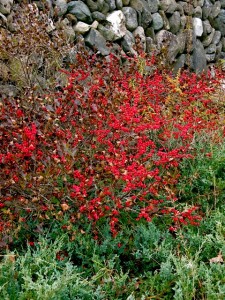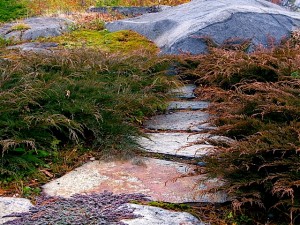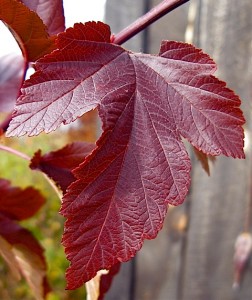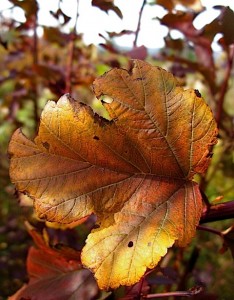Autumn Brilliance Part Three: Plant Partners for the Late Show and Early Winter Marquee…
 Acer palmatum x dissectum ‘Seiryu’ in late October
Acer palmatum x dissectum ‘Seiryu’ in late October
By late October, much of the foliage in the forest surrounding my garden has passed its peak. Although the woods are still basking in the glow of golden birch and poplar, lemony striped maple, rusty red oak and amber colored beech –  the vibrant orange and red maple leaves are now carpeting the woodland paths, where they rustle in the wind and crunch beneath my feet. Walks through the forest in late autumn are a fragrant affair; scented with musky dampness and memories. There is a beautiful sadness in the woods at this time of year – a melancholy enhanced by frequently-foggy mornings and low-lit afternoons…
 Acer palmatum x dissectum ‘Seiryu’ foliage in late October
Acer palmatum x dissectum ‘Seiryu’ foliage in late October
In my garden, most flowers vanished with the recent hard frost – but the ornamental fruit and foliage, stars of autumn’s late-show, are still going strong. Now through mid November, the leading role belongs to my favorite tree, Acer palmatum x dissectum ‘Seiryu’. This Japanese maple, commonly known as ‘The Blue-Green Dragon’, (currently the only upright dissected-leaf cultivar), is planted at the bottom edge of a slope near my studio where it arches over the Secret Garden door. The Blue-Green Dragon is prized for its lacy, delicately cut foliage and its late season color. A true chameleon, this dragon changes from sea-green to golden chartreuse before lighting a brilliant blaze of orange. Finally, in mid November, the dragon’s heat simmers down to a coppery hue as her leaves slowly drop to the hidden walkway below. Nearby, Daphne x burkwoodii, ‘Carol Mackie’, has begun her own transformation; morphing from variegated green and white to a citrusy blend of lemon yellow, sweet orange and sour lime. The contrast between these two plants is particularly stunning in the last week of October and the first few days of November. Closer to ground-level, Bergenia ‘Bressingham Ruby’, planted at the foot of the entry wall to the Secret Garden, shines like a candy apple. Glossy green and elegant during the summer months, by late autumn Bergenia’s foliage has shifted hues from green to orange to cherry red – until finally settling on the ruby-wine color she will hold throughout the early winter months….
Further along the garden path, nestled into the nooks and crannies between ledgy outcrops bordering the main garden entrance, Calluna and Erica have begun to turn up their heat just as temperatures here dip below freezing. Calluna vulgaris ‘Multicolor’ has shifted to a shocking shade of vermillion, emphasized by the contrasting blue-tinted foliage of nearby Calluna vulgaris ‘Silver Knight’ and Juniperous horizontalis ‘Wiltonii’. Tiny lavender blossoms continue to flush the tips of the ‘Silver Knight’ heather, in spite of the cold – I gather them up in tiny bouquets for my kitchen table.
Ground covering woody plants, such as Calluna, Erica, Stephanadra, and Cotoneaster, offer vibrant late season color that combines well with with a wide variety of evergreens. Some of my favorites include juniper, (of all sizes and habits), Siberian cypress, (Microbiota), hemlock, (Tsuga), spruce, (Abies) and yew (Taxus). Blue-green masses of foliage and bronzing needle tips provide a soothing foreground or lush, calm backdrop for the more intense, late -autumnal hues in perennial and shrub borders…
 Calluna vulgaris ‘Multicolor’ and ‘Silver Knight’, planted with Juniperus horizontalis ‘Wiltonii’, (Blue rug), along the ledgy walkway at Ferncliff…
Calluna vulgaris ‘Multicolor’ and ‘Silver Knight’, planted with Juniperus horizontalis ‘Wiltonii’, (Blue rug), along the ledgy walkway at Ferncliff…
 Calluna vulgaris ‘Multicolor’, forms a blazing carpet against the gray ledge in late October…
Calluna vulgaris ‘Multicolor’, forms a blazing carpet against the gray ledge in late October…
 Juniperus squamata ‘Holger’, along the Secret Garden steps in October
Juniperus squamata ‘Holger’, along the Secret Garden steps in October
 Stephanandra incisa ‘Crispa’ glows golden-orange against the gray stone wall steps in late October
Stephanandra incisa ‘Crispa’ glows golden-orange against the gray stone wall steps in late October
 Stephanandra incisa and Juniperus Pfitzeriana ‘Aurea’ make a beautiful autumn pairing…
Stephanandra incisa and Juniperus Pfitzeriana ‘Aurea’ make a beautiful autumn pairing…
Of course fruiting shrubs and trees play an important role in my garden at this time of year and throughout the winter months. Yes, I fully admit to an obsession with colored berries. I collect and treasure fruiting shrubs for their shimmering, confetti-dot effect. While these plants are a feast for the eyes as winter draws near and color grows scarce, more importantly, their berries provide natural food for birds including the finch, cedar wax wings, cardinals and many others. As mentioned in my previous posts, (Autumn Brilliance Part One and also Autumn Brilliance Part Two), Callicarpa dichotoma and Viburnum, including the black-fruited V. carlesii, (Korean spice viburnum), provide berries for many of my feathered friends. As late fall shifts to early winter, other fruiting plants, such as Cotoneaster, begin to stand out in the garden. Ground-hugging Cotoneaster is a great partner for stonewalls, particularly in late autumn, when the bright red fruit and rusty foliage radiates in vibrant contrast to the rock’s cool, gray surface. I like to combine horizontal juniper cultivars with Cotoneaster, allowing both to trail down the side of retaining walls. Bright blue juniper berries sparkle on frosty mornings until they are devoured by hungry chipmunks and song sparrows. Ilex verticillata ‘Red sprite‘, a long-standing winter favorite, is just beginning its show-stopping performance. This mass of winterberry in my entry garden never fails to lift my spirits during the cold, raw days of late November. In the foreground, blue-tinted Juniperus chinensis ‘Sargentii’ enhances the orange-red brilliance of the berries and the beautiful gray-tones of Dan Snow’s stone wall rise up from behind. When snow finally dusts the winterberry branches, the red fruits float like cherries in a bowl of cream…
Ilex verticillata ‘Red sprite’ with Juniperus chinensis ‘Sargentii’ in late October
Ilex verticillata ‘Red sprite’ with Juniperus chinensis ‘Sargentti’ in late October
 Juniperus squamata ‘Holger’ and Thymus
Juniperus squamata ‘Holger’ and Thymus
 Cotoneaster dammeri ‘Eichholz’s, leaves turn burgundy red after the hard frost in October
Cotoneaster dammeri ‘Eichholz’s, leaves turn burgundy red after the hard frost in October
 This Juniperus horizontalis provides blue berries in addition to sea green foliage
This Juniperus horizontalis provides blue berries in addition to sea green foliage
 Viburnum carlesii, (Korean Spice Viburnum), provides late autumn foliage and black fruit. A small sized shrub, (3′ x 3′), Korean Spice Viburnum is generous with her fragrant flowers in spring…
Viburnum carlesii, (Korean Spice Viburnum), provides late autumn foliage and black fruit. A small sized shrub, (3′ x 3′), Korean Spice Viburnum is generous with her fragrant flowers in spring…
 Callicarpa dichotoma ‘Issai’, shown in an earlier post with golden foliage, is pictured after the hard frost in late October- looking even more magical than before…
Callicarpa dichotoma ‘Issai’, shown in an earlier post with golden foliage, is pictured after the hard frost in late October- looking even more magical than before…
Rich brown and subtle bronze tones also begin to appear in the late season, creating opportunities for harmonious pairings with brightly colored foliage and fruit. The cobalt violet hue of Callicarpa dichotoma ‘Issai’ berries, (above), seems even brighter once the shrub’s foliage turns a warm copper brown. Likewise, Microbiota decussata, (Siberian cypress), slowly burnishes from forest green to warm bronze as temperatures dip, playing beautifully against the orange-chartreuse tones of nearby moss and the pyrotechnic-color display of Enkianthus campanulatus ‘Red Bells’, planted at the corner of the walkway…
Microbiota decussata, (Siberian cypress), with Thyme and Moss on the path to the Northwest meadow in October…
 Enkianthus companulatus ‘Red Bells’, in October
Enkianthus companulatus ‘Red Bells’, in October
 Microbiota decussata, autumn color close-up
Microbiota decussata, autumn color close-up
 Northwest path to the meadow with a view of amber colored beech in the distance
Northwest path to the meadow with a view of amber colored beech in the distance
Although most of the flowers in my garden have faded away, some, such as Geranium ‘Brookside’, continue to surprise me past the first few frosts. When a fuchsia veined, blue-violet bloom appears amid the bright orange and yellow leaves of this gorgeous cranesbill, it can light up a gray October day almost as brightly as the sun. Placed near the golden autumn foliage of Amsonia illustris‘, this plant can easily stop me in my tracks with or without her stunning flowers. The dark hues of Physocarpus opulifolius ‘Diablo’ foliage, (or P. opulifolius ‘Summer wine’, or ‘Coppertinia’), pair nicely with these brighter plants, as do many ornamental grasses, dark violet colored sedum and verdigris tinted juniper…
 Geranium ‘Brookside’ foliage turns brilliant orange and scarlet. and continues to produce violet blue blossoms with fuscia veins well past the hard frost…
Geranium ‘Brookside’ foliage turns brilliant orange and scarlet. and continues to produce violet blue blossoms with fuscia veins well past the hard frost…
 Amsonia illustris, in the entry walk – golden autumn color enhanced by the late frost and nearby orange-hued ornamental grasses in October
Amsonia illustris, in the entry walk – golden autumn color enhanced by the late frost and nearby orange-hued ornamental grasses in October
Physocarpus opulifolius ‘Diablo’ foliage color, varies from deep oxblood red…
to burnished amber…
May the colors of late autumn lift your spirits and encourage you to venture out into the garden with an eye toward extending the season. With a bit of effort and planning, almost any patch of earth can provide a season-spanning garden, filled with color and texture throughout the year. I will meet you back here in just a bit, with more design inspiration for the coming months…
***
Article and photographs copyright 2009, Michaela at The Gardener’s Eden
All content on this site, (with noted exceptions), is the sole property of The Gardner’s Eden and may not be used or reproduced without express, written consent. Inspired by something you see here? Please give credit where credit is due. It’s a small world and link-love makes for fond friendships. Stealing makes for bad dreams…
***





